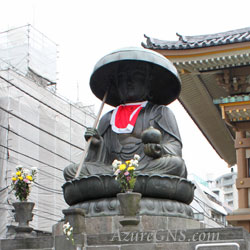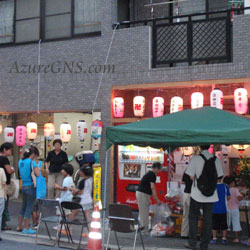(8月24日頃)
JIZO-BON
The JIZO-BON Festival
(on and around Aug 24th)
●地蔵盆
JIZO-BON
●地蔵菩薩
JIZO-BOSATSU; Ksitigarbha Bodhisattva
●新暦
solar calendar
●旧暦
lunar calendar
●お供え物
offering
●供える
(to) offer
●縁日
temple festival; shrine festival
●提灯
paper lantern; Japanese lantern; Chinese lantern
●ろうそく
candle
●線香
SENKO; stick incense
●お菓子
sweets
◆仏教では、地蔵菩薩は人々をお慈悲で苦しみから救ってくれると信じられています。
In Buddhism, JIZO-BOSATSU is believed to help people escape from suffering by showing mercy.
◆菩薩とはさとりを求める修行者という意味なので厳密には仏様ではありませんが、仏様同様に信仰の対象となっています。
People believe in BOSATSU as well as Buddha, though strictly speaking, it is not a Buddha but an ascetic for enlightenment.
◆大衆に広く信仰され、親しみを込めてお地蔵様とかお地蔵さんと呼ばれています。
It is widely worshiped by the public, and is called OJIZO-SAMA or OJIZO-SAN in a friendly way.
◆お地蔵様の起源は諸説ありますが、古代インドの神様が中国経由で奈良時代(710年-784年)に日本に入ってきたとされるのが一般的です。
It is generally said that OJIZO-SAMA was introduced to Japan from ancient India by way of China in the Nara era (710-784), though there are various theories on its origin.
◆お地蔵様は様々な姿に描かれていますが、最も多いのは左手に如意宝珠(にょいほうじゅ)、右手に錫杖(しゃくじゅ)を持つ立ち姿です。
OJIZO-SAMA is portrayed in various appearances, and the most common one is its standing posture with NYOIHOJYU (a wish fulfilling gem) in the left hand and SHAKUJYU (a monk staff) in the right.
◆お地蔵様は子供の成長を見守り、それゆえ多くの昔話や童謡に登場します。
OJIZO-SAMA is the guardian of children, so it often appears in old tales and children’s songs.
◆道祖神の信仰と融合した結果、旅人を守り道案内をして下さるとも信じられています。
OJIZO-SAMA is also believed to protect the land and travelers as a result of the fusion of the faiths of OJIZO-SAMA and DOSOJIN.
◆道祖神とは悪霊から土地や旅人を守る神で、石碑や石像の形で祀られます。
DOSOJIN is worshiped in the form of a stone monument or a stone statue as a god who guards the land and travelers against evil spirits.
◆そのため、お寺の中だけでなく、道端で多くのお地蔵様を見ることができます。
Therefore, we can see a lot of OJIZO-SAMA not only in the temples but also on the roadsides.
◆死者の鎮魂のため、墓地、事故現場、刑場などにも建立されています。
OJIZO-SAMA is also built in graveyards, at accident scenes, and execution grounds for the consolation of the souls of the dead.
◆お地蔵様の縁日は毎月24日に開かれますが、お盆の期間の縁日は地蔵盆と呼ばれて特別に盛大に行われます。
The temple festival of OJIZO-SAMA is held on the 24th of every month, and JIZO-BON, the festival around O-BON season, is one of the greatest occasions.
◆地蔵盆は関東は旧暦に従い7月24日頃、関西では1ヶ月後の8月24日頃に行われます。
JIZO-BON is held in the Kanto District around July 24th, according to the lunar calendar, and it is held one month later, around August 24th, in the Kansai Area.
◆より多くの人が参加できるように、最近では8月24日前後の土曜日、日曜日に日程をずらして行うことも多いです。
Recently, it is often held on Saturday and Sunday near August 24th so that more people can join in the festival.
◆全国で様々な形で行われますが、関西地方では特に盛んです。
It is celebrated in various ways throughout Japan, and it is especially popular in the Kansai Area.
◆地蔵盆の発祥の地と言われている京都では大人も子供も一緒になって積極的に楽しみます。
Both adults and children enjoy JIZO-BON actively in Kyoto which is said to be the birthplace of JIZO-BON.
◆一般的に地域のお寺、子供会、自治体が地蔵盆のお世話をします。
JIZO-BON is usually prepared by local temples, children’s gatherings, and neighborhood self-governing bodies.
◆お地蔵様をきれいに洗い清め、新しい赤い前だれをつけ、周りに赤い提灯をぶら下げます。
They wash and clean up OJIZO-SAMA, put a red bib on it, and red paper lanterns are hung around it.
◆お坊さんがお参りに来た子供達にお経をあげて下さり、その後お菓子が配れます。
Buddhist priests chant sutras for children who join the event, and they are given some sweets.
◆子供達は花火、ゲーム、福引などを楽しむこともあります。
Sometimes the children enjoy events such as fireworks, games, and lotteries.
(より詳しい情報は「我が家の地蔵盆」をご覧下さい。)
(Please see ‘My JIZO-BON Festival Experience’ for further information.)



